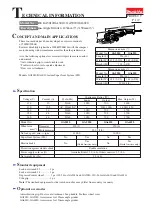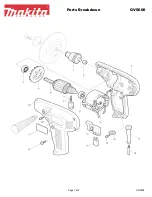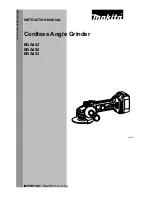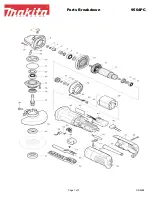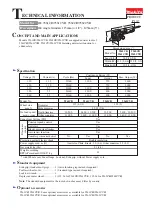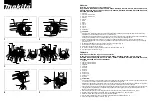
22
| English
1 609 929 L00 • 8.2.07
f
Do not restart the cutting operation in the
workpiece. Let the wheel reach full speed
and carefully reenter the cut.
The wheel may
bind, walk up or kickback if the power tool is
restarted in the workpiece.
f
Support panels or any oversized workpiece
to minimize the risk of wheel pinching and
kickback.
Large workpieces tend to sag under
their own weight. Supports must be placed under
the workpiece near the line of cut and near the
edge of the workpiece on both sides of the wheel.
f
Use extra caution when making a “pocket
cut” into existing walls or other blind areas.
The protruding wheel may cut gas or water pipes,
electrical wiring or objects that can cause kick-
back.
Safety warnings specific for sanding
operations
f
When sanding, do not use excessively over-
sized sanding disc paper. Follow manufac-
turers recommendations, when selecting
sanding paper.
Larger sanding paper extending
beyond the sanding pad presents a laceration haz-
ard and may cause snagging, tearing of the disc,
or kickback.
Safety warnings specific for wire
brushing operations
f
Be aware that wire bristles are thrown by the
brush even during ordinary operation. Do not
overstress the wires by applying excessive
load to the brush.
The wire bristles can easily
penetrate light clothing and/or skin.
f
If the use of a guard is recommended for
wire brushing, do not allow any interference
of the wire wheel or brush with the guard.
Wire wheel or brush may expand in diameter due
to work load and centrifugal forces.
Additional safety warnings
Wear safety goggles.
f
Use suitable detectors to determine if utility
lines are hidden in the work area or call the
local utility company for assistance.
Contact
with electric lines can lead to fire and electric
shock. Damaging a gas line can lead to explosion.
Penetrating a water line causes property damage
or may cause an electric shock.
f
Always use the protective devices specified
for the respective applicational case.
Protec-
tive devices not suitable for the applicational case
cannot cover off the grinding tool sufficiently.
f
When working stone, use dust extraction.
The vacuum cleaner must be approved for
the extraction of stone dust.
Using this equip-
ment reduces dust-related hazards.
f
Use a cutting guide when cutting stone.
With-
out sideward guidance, the cutting disc can jam
and cause kickback.
f
When working with the machine, always
hold it firmly with both hands and provide for
a secure stance.
The power tool is guided more
secure with both hands.
f
Secure the workpiece.
A workpiece clamped
with clamping devices or in a vice is held more
secure than by hand.
f
Do not work materials containing asbestos.
Asbestos is considered carcinogenic.
f
Take protective measures when dust can
develop during working that is harmful to
one’s health, combustible or explosive.
Example: Some dusts are regarded as carcino-
genic. Wear a dust mask and work with dust/chip
extraction when connectable.
f
Keep your workplace clean.
Blends of materi-
als are particularly dangerous. Dust from light
alloys can burn or explode.
f
Never use the machine with a damaged
cable. Do not touch the damaged cable and
pull the mains plug when the cable is dam-
aged while working.
Damaged cables increase
the risk of an electric shock.
Functional Description
Read all safety warnings and all
instructions.
Failure to follow the
warnings and instructions may result in
electric shock, fire and/or serious injury.
While reading the operating instructions, unfold the
graphics page for the machine and leave it open.
Intended Use
The machine is intended for cutting, roughing, and
brushing metal and stone materials without using
water.
For cutting metal, a special protection guard for cut-
ting (accessory) must be used.
For cutting stone, a special extraction hood for cutting
with cutting guide (accessory) must be used.
With approved sanding tools, the machine can be
used for sanding with sanding discs.
OBJ_BUCH-340-001.book Page 22 Thursday, February 8, 2007 8:55 AM































